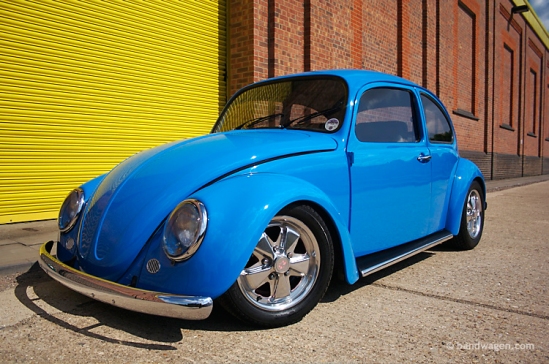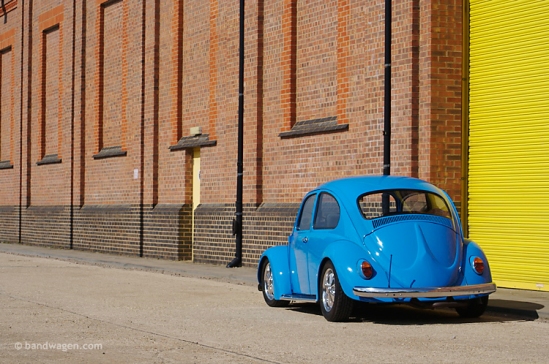 This blue Cal-look beetle was in my life for twenty two years. I purchased it with a friend back in 1988 with the intention of building a drag-car to enter the recently formed VWDRC. The basic plan was to weld up the doors, cut off the roof, fit a roll-cage and run a more or less stock 1600 engine on methanol and nitros oxide… this was back in a time when you could pick up as many used and running engines as you wanted, for around £50 each! The car only cost us £100 so we figured as long as we got a few quarter-mile runs out of each engine before they blew, it would be fairly inexpensive but fast fun!
This blue Cal-look beetle was in my life for twenty two years. I purchased it with a friend back in 1988 with the intention of building a drag-car to enter the recently formed VWDRC. The basic plan was to weld up the doors, cut off the roof, fit a roll-cage and run a more or less stock 1600 engine on methanol and nitros oxide… this was back in a time when you could pick up as many used and running engines as you wanted, for around £50 each! The car only cost us £100 so we figured as long as we got a few quarter-mile runs out of each engine before they blew, it would be fairly inexpensive but fast fun!
As you’ve probably guessed from the pictures, the plans changed drastically when my friend lost interest in the bug. Thank god he hadn’t got around to hacking the roof off! I bought his share in the car and decided to use it as the basis for a Cal-look project. Over the next couple of years I started collecting parts and in 1990 it went into the body shop to fit the early panels, some de-chroming and a respray in Ford electric blue.
Once painted, I rented a small, two-car barn on a local farm with another friend who was also working on a project beetle. The bug slowly came together over the following eight years. I’d work on it when time and money allowed which wasn’t too often – I was in my 20s and money was tight so there were usually other things that had to take priority, like paying the mortgage and food!
After a final push it was all together and driving in 1998 and I made it along to the Stonor Park VW show that year. Things have been updated and changed over the years including the addition of the 4″ narrowed beam in 2009 which was just before I decided to sell it. This beetle only covered 8,500 mile in the 22 years that I owned it which must be some kind of record! It’s still fairly local to me and owned by a friend of the guy who bought my ’72 Bay-window camper, but as they say, that’s another story…
Body:
Pre-67 front and rear valances, early wings and lights (US-Spec fronts containing orange indicators)
Long-bonnet and glass W-decklid.
Cal-look window rubbers.
De-chromed with smoothed/hidden catches on front and back lids.
Grey tinted one-piece door glass and matching rear side glass.
Stainless-steel blade bumpers.
Bodywork and paint by Paulespury coachworks in 1990 (still looks great!)
Running gear:
New front suspension set-up fitted by Sayed @ Batts VWs in 2008 comprising of:
4″ narrowed and adjustable front beam, custom built by Gavin @ Trailer Queen Restos
CB Dropped spindles
New KYB Front shocks
Long-travel ball joints
Rear…
Adjustable Koni shocks.
New IRS gaiters
Type 3 IRS Gearbox
UVA Adjustable rear spring plates.
Copper brake pipes fitted throughout
Standard drums and disks re-drilled to Porsche 5-stud (VW 4stud fitment still retained as well)
Wheels & Tyres:
Fully-polished early Porsche fuchs, 5.5×15 fronts and spare with 185/55R15 Continentals
Original deep 6×15 rears with 185/65R15 Nankangs
Engine:
Built by Sayed @ Batts VWs and fitted in Feb 2000 (only done 6K miles!)
1641cc fully balanced.
Twin 36 IDF webber carbs with hex-bar linkage.
Engle 110 Cam.
040 Cylinder heads.
Hi-volume oil pump.
Remote oil filter with braided lines.
009 Distributor and Bosch blue coil
Polished, louvered stainless firewall.
Engine tinware painted electric blue.
Interior:
Grey vinyl/velour high-back sports with matching side panels and rear seat.
Grey carpets.
Grey cloth headlining.
Short-throw T gearshift.
Custom painted speedo.
Grey sports steering wheel.
Fire extinguisher.
80s Pioneer cassette player with 4x speakers on custom rear parcel shelf.
Auto-watch Alarm & immobiliser.
Billet dash knobs and door handles/window winders and buttons.
Additional oil temp gauge.
I say…Nicely done!!!
Thanks for reading
Tim.
















